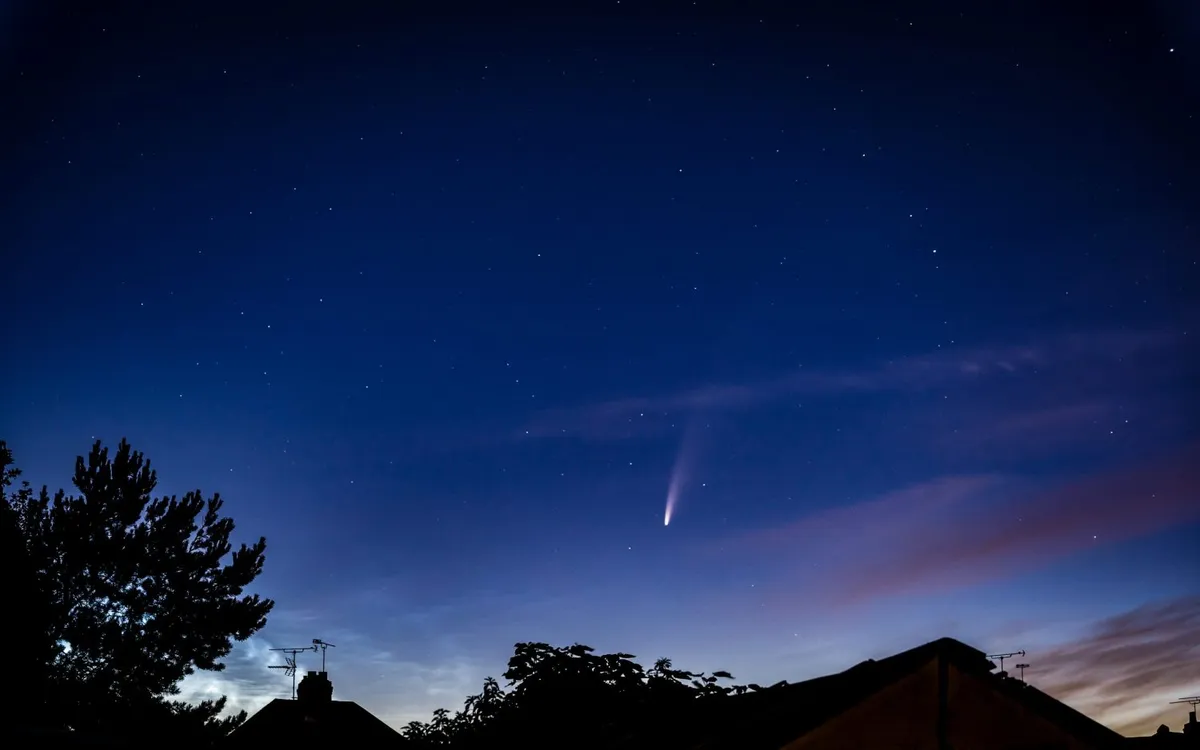Would you like to see a comet or asteroid tonight?
Comets, asteroids and other Near-Earth Objects (NEOs) are a fascinating sight to behold, if you can manage to spot one in the night sky.

Equipment: NikonZ6 Mod camera, Samyang 135mm lens. Comet (stacked): 60 photos (5sec, ISO 640, f2.8 ). Foreground: 5sec , Hdr
Many will remember the appearance of Comet Hale-Bopp in the 1990s, or much more recently, the beautiful sights of Comet NEOWISE and Comet C/2022 E3 ZTF that made headlines around the world and enticed us all to take a look up at the evening sky.
Asteroid Vesta, for example, is one member of the Asteroid Belt that can also be seen, provided you know where and when to look.
But how do you spot comets and asteroids in the night sky? Is there a comet tonight that's visible where you are?

Find out in our guide to which comets and asteroids are visible tonight and over the coming weeks.
For help understanding what our brightness indicators mean, read our guide to stellar magnitude.
If you're a complete beginner, get started with our guide to astronomy for beginners.
December 2025
Comet 24P/Schaumasse

Comet 24P/Schaumasse is a brightening comet best seen in the morning sky during December 2025.
On the morning of 1 December, find it near the star Algieba (Gamma (γ) Leonis).
It then tracks across the body and tail of Leo throughout the month, passing north of Denebola (Beta (β) Leonis) on the night of 18/19 December.
A few days after this, it enters the constellation of Coma Berenices on a track that will take it across a rich, deep galaxy field, encountering the likes of M98, M99, M100, M88, M91 and M90.
Throughout December, 24P/Schaumasse’s integrated magnitude is expected to increase from around mag. +11.5 on 1 December to +10.0 on New Year’s Eve.
This places it within small-telescope territory and, given clear skies, it’s going to be an exciting object to keep tabs on.
The comet has an orbital period of 8.252 years, with its next perihelion on 8 January 2026.
During this time, it’s expected to reach mag. +9.9 and will be located in southern Boötes, the bright star Arcturus (Alpha (α) Boötis), then providing a convenient navigational aid for locating the comet in the early morning sky.
Asteroid 16 Psyche

Asteroid 16 Psyche reaches opposition on 8 December in an easy-to-navigate part of the sky, just east of the Hyades open cluster and the bright star Aldebaran (Alpha (α) Tauri).
Its path over the course of the month is fairly short too, so once identified, it will be easy to keep track of.
Psyche starts December 7.5° east and a fraction north of Aldebaran. At 00:00 UT on 1 December, this positions it 0.5° south and slightly west of the mag. +4.9 star 104 Tauri.
Psyche’s monthly track has it moving west against the background stars, curving very gently south in the first half of December, then slightly north again in the second half of the month.
At 00:00 UT on 31 December, the asteroid sits 1.8° northeast of Aldebaran.
Psyche’s magnitude stays relatively steady, brightening from mag. +9.8 on 1 December to +9.6 at opposition on 8 December, then dimming to +10.2 by the end of the month.
This places it within small-telescope range, and its high altitude in UK skies makes it an excellent target for beginners.
Psyche is thought to be the iron core of a failed planet. Shaped like a potato and measuring roughly 279km by 323km by 189km, its iron composition means it’s unusually massive for an asteroid – around 2.3 × 10¹⁹kg.
It orbits the Sun at an average distance of 2.9 AU. It takes just under five years to complete each orbit, rotating once every 4.2 hours.
October 2025
C/2025 A6 (LEMMON)
Comet C/2025 A6 (Lemmon) is the comet on everyone's lips right now. Get the story so far and find out how to observe it in our regularly-updated Comet Lemmon blog.
Ceres

Dwarf planet Ceres reaches opposition in the constellation of Cetus on 2 October.
Cetus is well positioned this month, reaching its highest point at: 01:30 BST (00:30 UT) on 1 October; 00:30 BST (23:30 UT) on 15 October; and 22:30 UT on 31 October.
Starting the month at mag. +7.5 and fading only slightly to mag. +7.9 by the end, Ceres is a viable binocular target, and small telescopes and smart scopes will have no trouble picking it up.
The key stars that will help you navigate to Ceres are mag. +3.4 Eta (η) Ceti and mag. +4.8 Phi1 (φ1) Ceti.
On 1 October, Ceres lies 2° to the west-northwest of Eta Ceti. It then tracks west in a gentle south-pointing arc, passing just 4 arcminutes south of mag. +5.2 Phi2 (φ2) Ceti on the night of 12/13 October.
At mag. +7.7, it passes 20 arcminutes south of Phi1 Ceti on the nights of 19/20 and 20/21 October.
Ceres is a large body measuring 939km across and can reach mag. +6.7 during favourable oppositions.
Observing it is straightforward: record the star field over several nights and then compare your images. The object that shifts position between frames is likely to be Ceres.
Asteroid 12 Victoria

The minor planet 12 Victoria reaches opposition on 5 November, when it can be seen shining at mag. +9.9 within the borders of Aries, not too far from mag. +5.7 Mu (μ) Arietis.
Victoria remains in Aries throughout October and November, appearing to travel along a straight line from northeast to southwest. You’ll need a small telescope to see it.
On 1 October, Victoria will appear to shine at mag. +10.7 and can be found 9° to the west of mag. +2.9 Alcyone (Eta (η) Tauri), the brightest star in the Pleiades.
That starting position is just west of the mid-point between mag. +5.4 52 Arietis and mag. +4.8 Zeta (ζ) Arietis.
On 15/16 and 16/17 October, Victoria travels just to the north of mag. +4.6 Epsilon (ε) Arietis. Visually, there’s a fainter star, mag. +6.7 HIP 13892, lying 17 arcminutes north of Epsilon.
Victoria will skirt this star by around 3 arcminutes just before dawn on 16 October.
Discovered by English astronomer John Russell Hind in 1850, 12 Victoria is named after the Roman goddess of victory, and in honour of Queen Victoria.
It’s around 120km across and orbits within the main asteroid belt. It’s a siliceous or stony (S-type) asteroid that varies in magnitude as seen from Earth, from mag. +8.7 at favourable oppositions to mag. +12.8.
Analysis using using radar and speckle interferometry suggests 12 Victoria has an elongated shape and might be a binary asteroid being orbited by an irregularly shaped moon.
September 2025
Comet C/2024 E1 (Wierzchoś)

Comet C/2024 E1 (Wierzchoś) is set to be a slow burner throughout autumn 2025, rising from a dim 13th magnitude at the start of September to possibly mag. +5 at the start of 2026.
Sadly, at its brightest it will be in southern Sagittarius, too low and too close to the Sun to be seen properly from the UK.
But that doesn’t mean we can’t enjoy the show until mid-November, by which time the comet will hopefully be approaching eighth magnitude.
This is a hyperbolic comet inbound from the Oort cloud.
It was discovered in March 2024 by the Polish astronomer Kacper Wierzchoś during a routine survey at Mount Lemmon Observatory in the Santa Catalina Mountains, Arizona.
It was captured by an f/1.6, 1.5-metre Cassegrain telescope using a 111.5MP CCD camera, when it was around 20th magnitude.
Its perihelion will be 20 January 2026, when it will swing past the Sun at a distance of 0.5656 AU (84.6 million kilometres).
On 1 September, at an estimated mag. +13.1, C/2024 E1 will be 10° north of mag. +4.1 Epsilon (ε) Coronae Borealis.
It passes just east of it on 22 September, having increased to around mag. +12.5. It continues southward, passing west of mag. +3.7 Gamma (γ) Herculis on the evening of 8 October, when it will have brightened to mag. +11.9.
For added interest, slightly brighter comet C/2025 A6 (Lemmon) will be shining around mag. +10 in late October, passing south of Corona Borealis.
The two comets end October around 8° apart.
Send us your comet images by emailing contactus@skyatnightmagazine.com.

